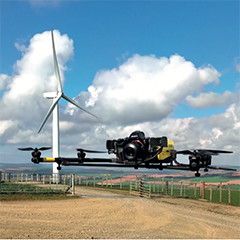With the rapid growth in availability of drones and access to commercial drone certification, the wind farm industry is becoming overrun with inexperienced operators offering drone inspection services. At the other extreme, advances in technology means that autonomous drone services are now being offered as a safer, more efficient alternative to wind turbine inspections. Having worked all over the UK for over five years, Derek Fett, founder and director of Aerial Media Scotland and his team are highly skilled drone operators inspecting over 1,800 blades across 46 farms to date. PES is excited to bring you this informative insight.
Derek knows first-hand what it takes to deliver wind turbine inspections safely and accurately. In this article, Derek offers his guidance on what to look for when selecting a drone inspection service and why he believes that Aerial Media Scotland is delivering industry best practice.
Conducting wind turbine inspections is an expensive and vital part of running any onshore wind farm. Traditionally blade and tower inspection is a slow process that is inherently dangerous. Wind turbines require to be stopped and manually inspected by rope access, taking up to a day at a time to complete one possibly two turbines and months to inspect a full wind farm. Having a rope technician scaling 80-metre-high towers in high winds is an extremely dangerous, timely and costly process. As a result, the use of drone technology is increasingly taking off in this field.
The use of drone technology, or Unmanned Aerial Vehicles (UAVs), is being deployed to inspect the blades of the turbines for signs of lightning defects, erosion and strike damage as well as blade fatigue. Using UAVs means up to eight wind turbine inspections can be conducted in one day, meaning a turbine is only shut down for a short period, typically around 50 minutes, saving hundreds of man hours. The other key benefit to the wind farm owners is the loss of production is dramatically reduced. Using drone technology also allows for Close Visual Inspections (CVIs), thereby improving the quality and accuracy of the inspection.
Wind farm operators are now taking notice of these benefits and increasingly contracting UAVs for tower and blade inspections. The challenge facing many wind farm owners and operators is knowing who to select.



























